Abstract
STUDY OBJECTIVE: To assess the relation between leisure time physical activity (LTPA) during the first 20 weeks of pregnancy and the risk of developing pre-eclampsia and gestational hypertension. DESIGN: Case-control study carried out over a 28 month period with retrospective data collection. SETTING: Six hospitals in Quebec City and four hospitals in Montreal. PARTICIPANTS: 172 women with pre-eclampsia, 254 with gestational diabetes, 505 controls. All were primiparous, with no history of high blood pressure before pregnancy (unless due to oral contraceptive use), or during the first 20 weeks of gestation. Cases were defined using recognised criteria, and 97% of those eligible agreed to be interviewed. Controls delivered in same hospital immediately after cases and had no more than one reading of elevated blood pressure during pregnancy; 96% of those eligible agreed to be interviewed. MEASUREMENTS AND MAIN RESULTS: Participants were interviewed in hospital a few days after delivery using a questionnaire. Information was collected on type, frequency and average duration of any LTPA performed regularly during the first 20 weeks of pregnancy, together with medical, obstetric and sociodemographic details. It was found that women who performed regular LTPA had a reduced risk of pre-eclampsia (adjusted RR 0.67, 95% CI 0.46-0.96) and gestational hypertension (aRR 0.75, 95% CI 0.54-1.05), and the relative risks decreased as the average time spent in LTPA increased (aRR for pre-eclampsia among women with low, moderate and high energy expenditure: 1.00, 0.77 and 0.57, p = 0.01). The same trend was present for gestational hypertension (1.00, 0.80 and 0.71, respectively, p = 0.08). CONCLUSIONS: Leisure time physical activity during the first half of pregnancy is likely to reduce the risk of pre-eclampsia and gestational hypertension.
Full text
PDF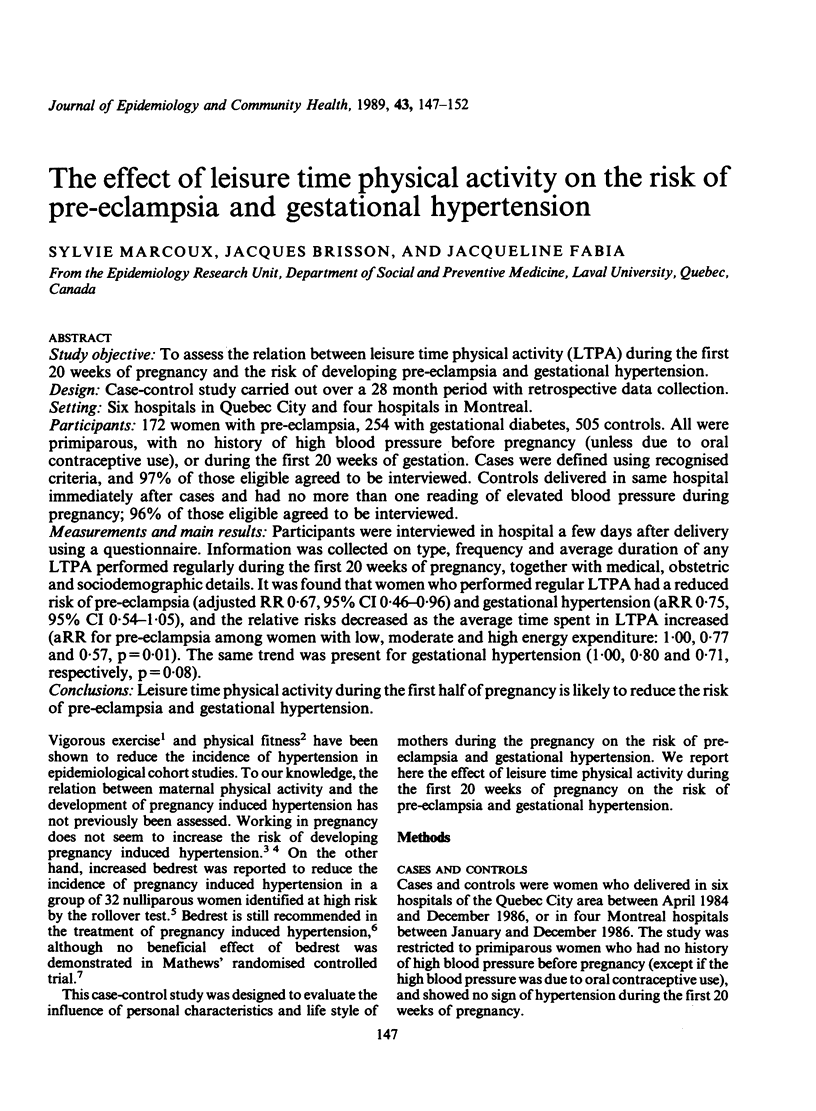
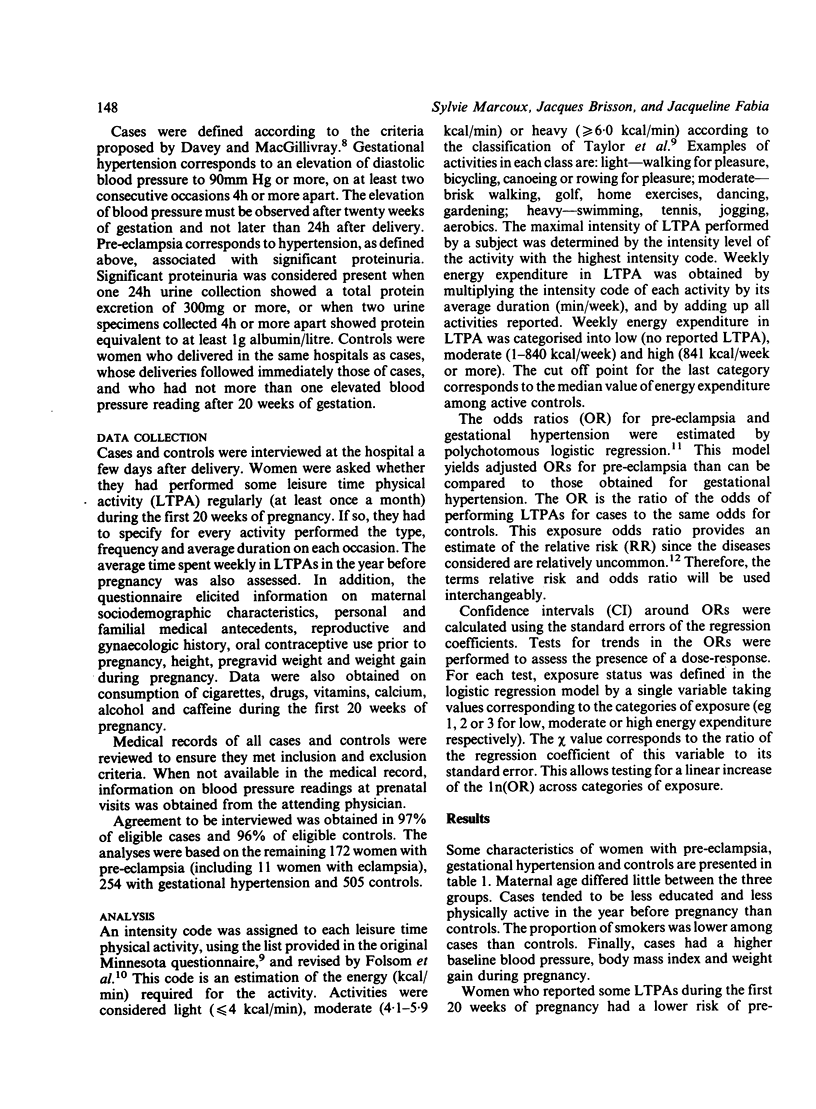
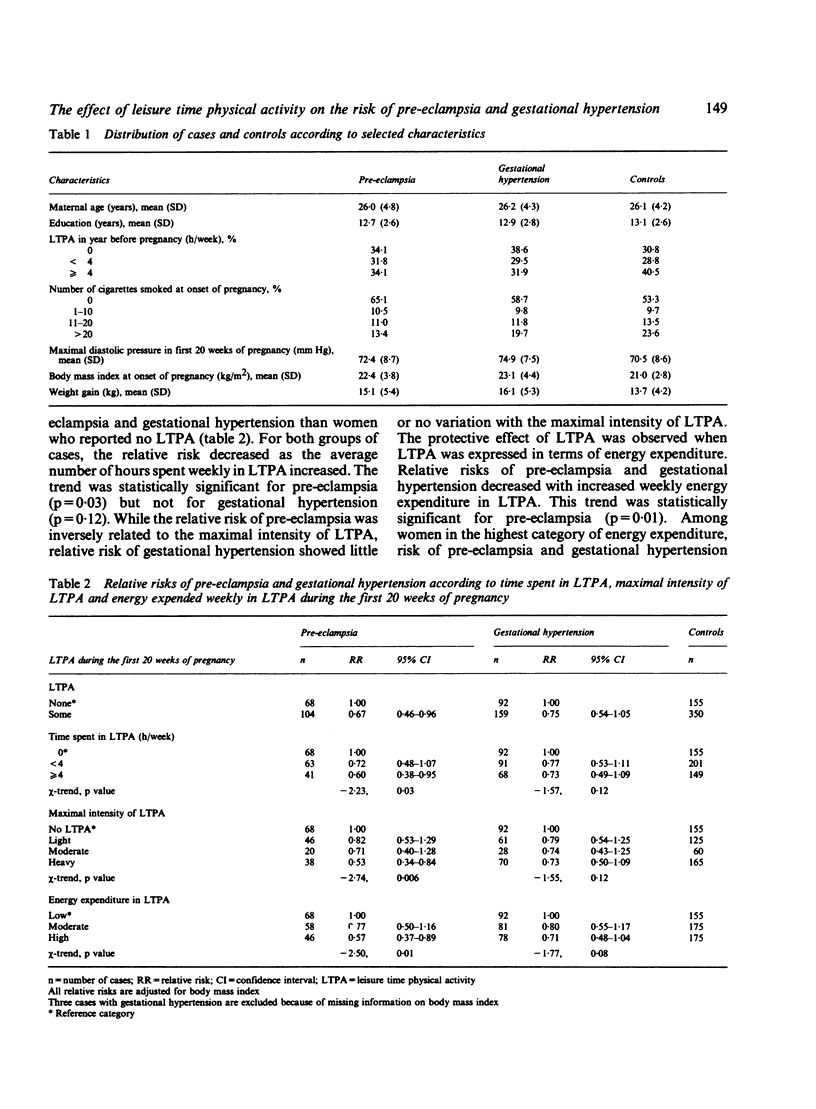
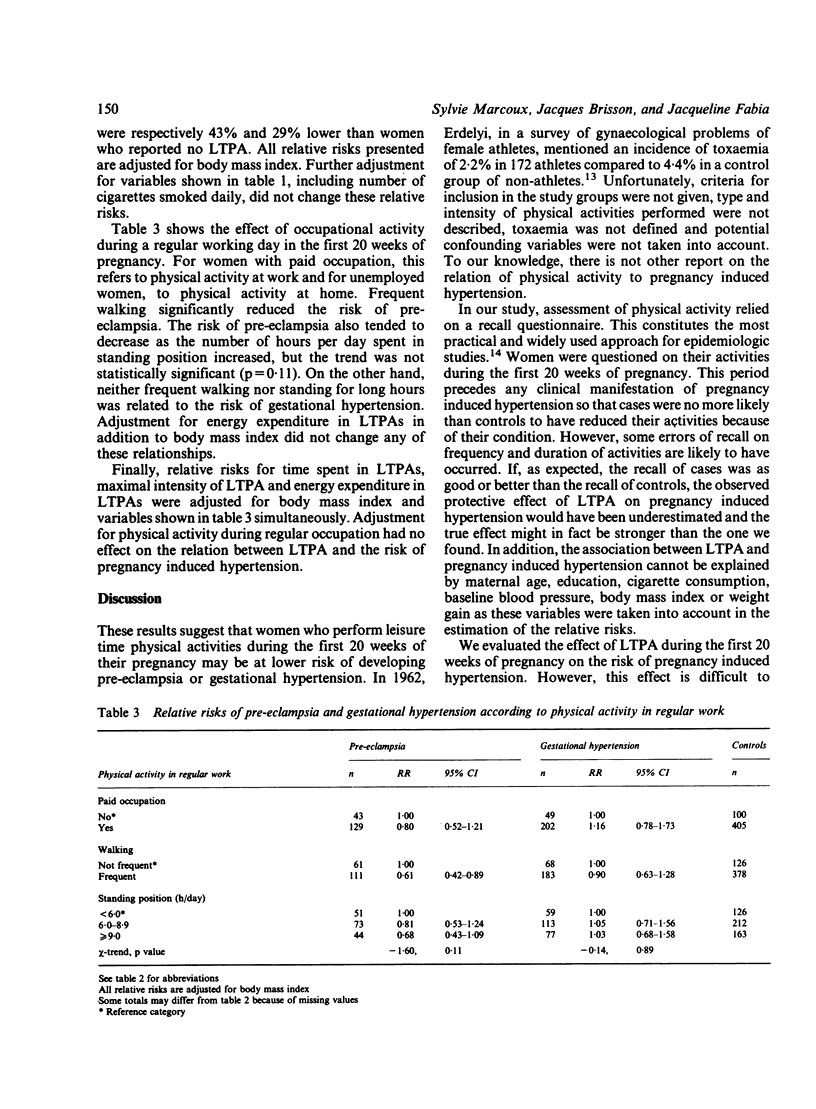
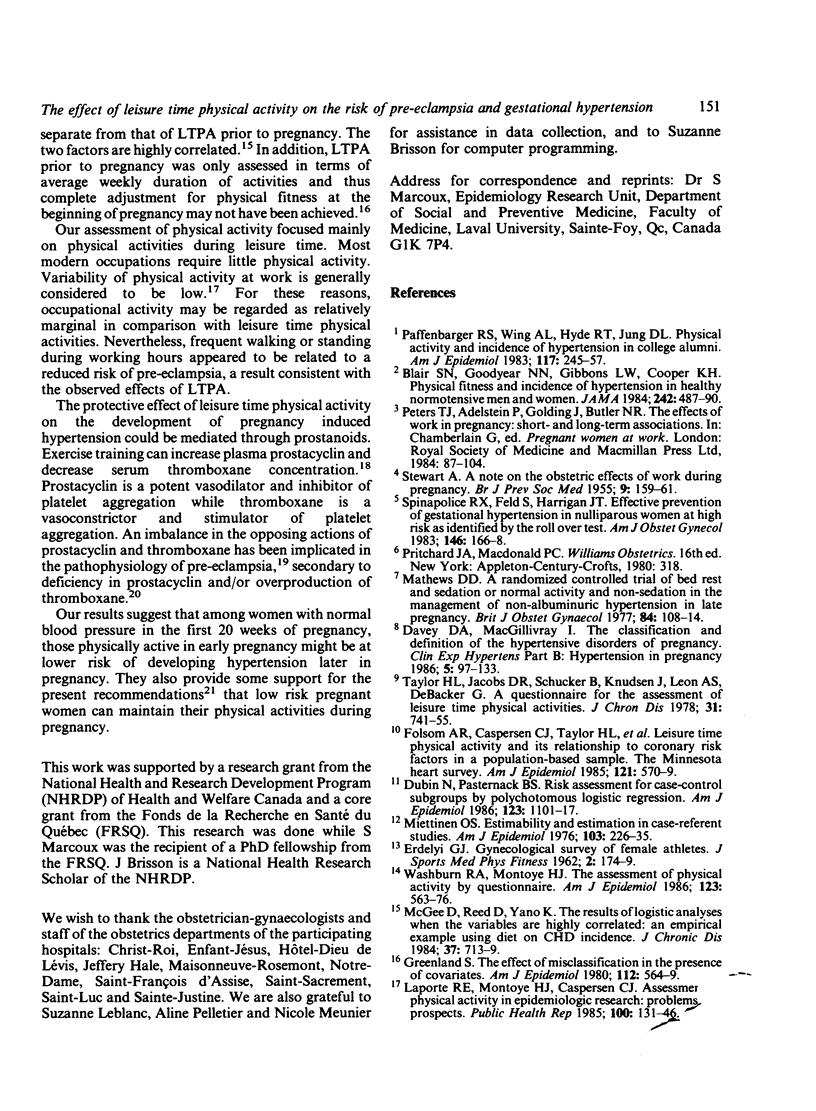

Selected References
These references are in PubMed. This may not be the complete list of references from this article.
- Blair S. N., Goodyear N. N., Gibbons L. W., Cooper K. H. Physical fitness and incidence of hypertension in healthy normotensive men and women. JAMA. 1984 Jul 27;252(4):487–490. [PubMed] [Google Scholar]
- Dubin N., Pasternack B. S. Risk assessment for case-control subgroups by polychotomous logistic regression. Am J Epidemiol. 1986 Jun;123(6):1101–1117. doi: 10.1093/oxfordjournals.aje.a114338. [DOI] [PubMed] [Google Scholar]
- Folsom A. R., Caspersen C. J., Taylor H. L., Jacobs D. R., Jr, Luepker R. V., Gomez-Marin O., Gillum R. F., Blackburn H. Leisure time physical activity and its relationship to coronary risk factors in a population-based sample. The Minnesota Heart Survey. Am J Epidemiol. 1985 Apr;121(4):570–579. doi: 10.1093/oxfordjournals.aje.a114035. [DOI] [PubMed] [Google Scholar]
- Greenland S. The effect of misclassification in the presence of covariates. Am J Epidemiol. 1980 Oct;112(4):564–569. doi: 10.1093/oxfordjournals.aje.a113025. [DOI] [PubMed] [Google Scholar]
- Mathews D. D. A randomized controlled trial of bed rest and sedation or normal activity and non-sedation in the management of non-albuminuric hypertension in late pregnancy. Br J Obstet Gynaecol. 1977 Feb;84(2):108–114. doi: 10.1111/j.1471-0528.1977.tb12535.x. [DOI] [PubMed] [Google Scholar]
- McGee D., Reed D., Yano K. The results of logistic analyses when the variables are highly correlated: an empirical example using diet and CHD incidence. J Chronic Dis. 1984;37(9-10):713–719. doi: 10.1016/0021-9681(84)90040-7. [DOI] [PubMed] [Google Scholar]
- Miettinen O. Estimability and estimation in case-referent studies. Am J Epidemiol. 1976 Feb;103(2):226–235. doi: 10.1093/oxfordjournals.aje.a112220. [DOI] [PubMed] [Google Scholar]
- Mirotznik J., Speedling E., Stein R., Bronz C. Cardiovascular fitness program: factors associated with participation and adherence. Public Health Rep. 1985 Jan-Feb;100(1):13–18. [PMC free article] [PubMed] [Google Scholar]
- Paffenbarger R. S., Jr, Wing A. L., Hyde R. T., Jung D. L. Physical activity and incidence of hypertension in college alumni. Am J Epidemiol. 1983 Mar;117(3):245–257. doi: 10.1093/oxfordjournals.aje.a113537. [DOI] [PubMed] [Google Scholar]
- Rauramaa R., Salonen J. T., Kukkonen-Harjula K., Seppänen K., Seppälä E., Vapaatalo H., Huttunen J. K. Effects of mild physical exercise on serum lipoproteins and metabolites of arachidonic acid: a controlled randomised trial in middle aged men. Br Med J (Clin Res Ed) 1984 Feb 25;288(6417):603–606. doi: 10.1136/bmj.288.6417.603. [DOI] [PMC free article] [PubMed] [Google Scholar]
- STEWART A. A note on the obstetric effects of work during pregnancy. Br J Prev Soc Med. 1955 Jul;9(3):159–161. doi: 10.1136/jech.9.3.159. [DOI] [PMC free article] [PubMed] [Google Scholar]
- Spinapolice R. X., Feld S., Harrigan J. T. Effective prevention of gestational hypertension in nulliparous women at high risk as identified by the rollover test. Am J Obstet Gynecol. 1983 May 15;146(2):166–168. doi: 10.1016/0002-9378(83)91047-5. [DOI] [PubMed] [Google Scholar]
- Taylor H. L., Jacobs D. R., Jr, Schucker B., Knudsen J., Leon A. S., Debacker G. A questionnaire for the assessment of leisure time physical activities. J Chronic Dis. 1978;31(12):741–755. doi: 10.1016/0021-9681(78)90058-9. [DOI] [PubMed] [Google Scholar]
- Walsh S. W. Preeclampsia: an imbalance in placental prostacyclin and thromboxane production. Am J Obstet Gynecol. 1985 Jun 1;152(3):335–340. doi: 10.1016/s0002-9378(85)80223-4. [DOI] [PubMed] [Google Scholar]
- Washburn R. A., Montoye H. J. The assessment of physical activity by questionnaire. Am J Epidemiol. 1986 Apr;123(4):563–576. doi: 10.1093/oxfordjournals.aje.a114277. [DOI] [PubMed] [Google Scholar]


